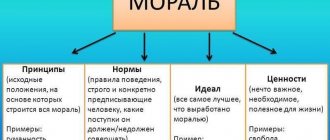Means of communication are techniques for encoding, transforming and decoding information transmitted during communication interaction. Communication means are divided into two large blocks: speech and non-speech blocks, i.e. verbal and non-verbal means of communication. Speech is the process of using language for the purpose of communication interactions between individuals. Language is a sign system, the main function of which is to ensure communication between people, thinking, and a method of expressing an individual’s self-awareness. Speech as a method of verbal communication acts simultaneously as a source of information and a method of influencing communication partners.
Language as a means of communication
The means of communication include, first of all, language, intonation of speech and emotional expressiveness, facial expressions and gestures, postures.
Language as a means of communication between individuals is closely interconnected with society, its culture and the individuals who live and work in it, while using the language in a varied and extensive manner.
Communication or communication is the transmission of any information from one individual to another for a different purpose. Communication is the result of the communicative interaction of two or more persons in specific circumstances and in the presence of a universal means of communication.
Language is considered the main means of human communication. The purpose of language to be a mechanism of communication is called its communicative function. By interacting with each other, individuals transmit their own thoughts, worldviews, emotions and emotional disturbances, mutually influence each other in a certain direction, and achieve a common understanding. With the help of language, subjects of interpersonal interaction understand each other. It gives them the opportunity to establish collective work in all areas of human activity. Language is the force that determines the existence and development of individuals and society as a whole. And the communicative function is the leading social function of language. However, it is far from its only function. Its specialized functions include cognitive, expressive, nominative and accumulative.
The ability to express information, broadcast it and influence the interlocutor is called the expressive function of language. This function is considered as the unity of expression and transmission of data, feelings and emotional experiences, and the will of the speaker.
The cognitive function is interconnected with the presence of human consciousness in linguistic signs. Language is a unique instrument of consciousness that reflects the results of a person’s cognitive activity. Linguistic disputes about what comes first, mental activity or language, will probably never stop. The only correct judgment is the statement that language has an inextricable connection with thinking, since humanity not only expresses its own thoughts in words, but also thoughts are formulated in the form of words - a person thinks in words. The cognitive function of the psyche is intended to record the consequences of mental activity and apply them in communication. This function promotes knowledge of the world and its verbalization.
A person thinks using categories, and in the course of cognition, he discovers and names new phenomena and concepts for himself, which is the nominative function of language. It has a close connection with the cognitive, since everything known must necessarily have its own name. It also has a connection with the ability of linguistic signs to designate things. It is this ability that allows an individual to create a world of symbols. However, in the modern world there are many things that do not have names.
The accumulative function is closely related to the collection and storage of information. After all, it is no secret to anyone that language has existed much longer than people and people. A striking example of this is dead languages that outlive their speakers. Language, regardless of whether it exists today or not, preserves the memory of generations and the centuries-old history of mankind. After all, even with the loss of oral speech, it is possible to master ancient writings and draw certain conclusions about the past life of a nation.
Language can also be spoken and written. The leading form of a language is its sound component. Unwritten languages may also exist. When there is only written recording, and no voicing, then the language becomes dead.
By what means did they communicate?
The German used words, and the Hungarian used gestures and body movements. Both one means of communication and the second occupy a lot of space in our lives.
What means of communication do people prefer? There is a Scandinavian saga about communication, which was retold by academician A.A. Beletsky. It tells how one day a dispute took place between a sage theologian and a Viking eye. The theologian showed one finger, to which the one-eyed Viking responded. showing two fingers.
The theologian showed three fingers, after which the Viking showed his fist, then the theologian ate the cherry and spat out the pit. The Viking found a gooseberry in his pocket and ate it.
Here the theologian admitted defeat. “What were you arguing about?” — The jury members asked the theologian. “I showed one finger, indicating that there is only one God in the world. He objected with two fingers, besides God the Father, there is also God the Son. I then showed three fingers, meaning that to be precise, there is also the Holy Spirit. To this he showed his fist, answering that the Trinity is still one.
I felt that I could not defeat him in theology, and changed the topic of the debate.
After eating the cherry, I said that life is sweet. But even here he answered me very aptly: having eaten gooseberries, he confirmed that one must live even when life is sour, “What were you arguing about? “They asked the one-eyed Viking. “I didn’t even think of arguing with him on theological topics. This impudent person showed that I have one eye. I told him that my one eye is worth his two.
He continued: he and I together have three eyes. After that, I said that impudent people like him should be taught not with scientific disputes, but with the fist. So I ate gooseberries to show that his life after this would be sour.”
Nonverbal communication
The means of communication between people, as mentioned above, are verbal, i.e. associated with the human speech apparatus, and non-verbal (non-verbal). In situations of language deficiency (for example, lack of universal language means), interpersonal interaction may occur through nonverbal means. After all, through them humanity has been communicating since time immemorial.
Nonverbal means of communication appeared much earlier than language systems. That is why they are sometimes called natural, that is, given to humanity by nature, and not invented by people.
Non-verbal means of communication are: facial expressions, postures, various gestures, style of movement of subjects, etc. They replace and complement speech, convey the emotional mood of communication partners. The main detail of such communications is the human body, which has a wide range of means and methods of transmitting information and contains all categories of individual self-expression. Psychologists say that the correct interpretation of nonverbal signals is the main condition for effective communication.
Knowledge of non-verbal “language” helps not only to better recognize and understand a partner, but also to anticipate what impression the information he hears will make on him, even before the moment of voicing it.
Mimicry comes from the Greek word mimikos, which means imitating. Facial expressions are the movement of facial muscles. The main element of facial expressions is the facial code, which consists of a special combination of elements and components of the face. Such elements and parts include: the position of the lips and eyebrows, the shape and brightness of the eyes, which convey emotional states, etc. Psychologists have identified six main codes of facial expressions and a lot of nuances of the transition from one code to another. The main facial codes include: suffering, anger, fear, contempt, surprise, joy.
An additional important source of data about the mood and intentions of the interlocutor is the subject’s body, its dynamics or static state. Pose translated from French means body position. It means a more or less stable spatial position of a person. Today, there are more than a thousand such provisions, the satisfactory or unacceptability of which depends on the nationality, gender, age category, cultural characteristics and religious preferences of people. The main semantic essence of a pose as a means of communication is to express openness or closedness, readiness for communication or unpreparedness for it.
Gestures are divided into rhythmic, emotional, pointing and inventive. Rhythmic gestures are correspondingly associated with the rhythm of speech. They highlight logical stress, acceleration or deceleration of tempo, places of intervals, that is, everything that an individual usually conveys using intonation. For example, this could be: beating a musical beat with your foot, shaking your body or head, etc. Various shades of feelings convey emotional gestures. Most of them are fixed in stable combinations - phraseological units. For example: slapping yourself on your own forehead means an unexpected guess or memory.
To distinguish objects from a number of similar ones, to indicate their location and order, pointing gestures are used. Often speech without the use of a pointing gesture becomes completely incomprehensible. There are certain types of phrases that involve the use of pointing gestures. For example, please give me this book. You can point not only with your hands and fingers, but also with your gaze, nod of your head, or turn of your torso. Pointing gestures can be multi-valued, i.e. Under different conditions, similar gestures take on completely different meanings. For example, pointing your fingers at your wrist, where you usually wear your watch, can mean asking how much time is left until the end of a lecture, seminar, class, etc. or a hint that there is little time left or that you need to hurry.
When there is not enough time or there is no opportunity to quickly express your own thoughts, you can depict an object, phenomenon or action using figurative gestures. They enhance the impact on the interlocutor, while causing him to have a clearer and clearer understanding of the topic of conversation or the subject of speech.
Typical situations in communication are served by symbolic gestures. For example, you can greet a colleague with a nod of your head or a wave of your hand. Each of the symbolic gestures is selected in accordance with the situation and depends on the gender, age category, social role and status, and level of culture of the communicant.
Kinesic means of communication are the subject's movement style and gait. Research by psychologists demonstrates that the emotional state can influence an individual’s gait, as a result of which it is possible to assess the potential effectiveness of communication without approaching the interlocutor.
Nonverbal means of communication also include prosodic and extralinguistic means. Prosody in Greek means stress or refrain. That is, prosody is responsible for the rhythmic and intonation characteristics of speech, such as: volume and pitch of the voice, stress strength and voice timbre. Individual prosodic features in an individual are inherent in nature, but much can be corrected through systematic work. Extralinguistic means of communication are closely interconnected with prosody. These include: intervals, sighs, coughing, laughter, crying, etc. Prosodic and extralinguistic non-verbal means of communication regulate speech flows. They complement and at the same time save linguistic communications, replace and foreshadow speech utterances, and demonstrate emotional states.
Dynamic touches with the body, in the form of pats on the back, shoulder, knee, handshakes, kisses, are called tactical means of communication. The choice of one of the forms of tactical means is determined by many factors, such as: nationality, gender, age, degree of acquaintance, social status.
Proxemic means of communication consist in the distance that interlocutors use between themselves. Anthropologist E. Hall introduced the main comfort zones of interpersonal interaction. Their distance depends on the degree of proximity of individuals to each other.
Intimate distance is intended for communication between close people and relatives and is an interval from touch to 45 cm.
The personal distance is intended for communication with familiar subjects and ranges from 45 cm to 1.20 m.
Social distance is intended for official communication and communication with strangers and ranges from 1.20 to 4 m.
The public distance is intended for communication with the audience and ranges from 4 m to 7.5 m.
Violation of established boundaries in certain communication conditions can cause misunderstanding, misunderstanding and even lead to a conflict situation.
Levels and forms of communication
In foreign and domestic psychology there are different views on the levels of communication.
Levels of communication according to B.G. Ananyev:
1) micro level - consists of the smallest elements of interpersonal communication with the immediate environment with which a person lives and most often comes into contact (family, friends);
2) meso level - communication at the level of the school, production team, etc.;
3) the macro level includes such large structures as management and trade.
Levels of communication according to E. Bern:
1) rituals are a certain order of actions by which a custom is performed and consolidated;
2) pastimes (watching TV, reading books, dancing, etc.);
3) games – activities that do not result in the production of any product;
4) intimacy – intimate relationships;
5) activity – a specific type of human activity aimed at understanding and transforming the surrounding world.
The most common level system in Russian psychology is:
1) primitive level - involves the implementation of a communication scheme in which the interlocutor is not a partner, but a necessary or interfering object. In this case, the contact phases are performed in the extension from above or (with a frankly strong partner) from below. A similar level of communication is offered in a state of intoxication, anger, conflict, etc.;
2) manipulative level - the partner-opponent scheme is implemented in a game that absolutely must be won, and the win is a benefit (material, everyday or psychological). At the same time, the manipulator catches and tries to exploit the partner’s weaknesses;
3) standardized level - communication based on standards, when one of the partners (or both) does not want contact, but cannot do without it;
4) conventional level – the level of ordinary equal human communication within the framework of accepted rules of behavior. This level requires partners to have a high culture of communication, which can be considered as an art and to master which another person has to work on himself for years. It is optimal for resolving personal and interpersonal problems in human contacts;
5) gaming level - also characterized as conventional, but with an increased positive focus on the partner, interest in him and the desire to generate a similar interest in himself on the part of the partner. The main thing in the game is to intrigue and interest your partner. At this level, the human connection that has arisen is valued more than the informative component of communication. Ideal for teaching;
6) level of business communication - compared to the conventional level, it implies an increased focus on the partner as a participant in collective activities. The main thing at this level is the degree of mental and business activity of the partner, his involvement in the common task. Ideal for group activities, brainstorming sessions, etc.;
7) spiritual level - the highest level of human communication, which is characterized by mutual dissolution in the partner, high spontaneity of thoughts and feelings, extreme freedom of expression, the partner is perceived as a bearer of the spiritual principle, and this principle awakens in us a feeling that is akin to reverence.
Forms of interpersonal communication:
1) monologue - when only one of the partners is assigned the role of an active participant, and the other - a passive performer (for example, a lecture, notation, etc.);
2) dialogue - characterized by cooperation between participants - interlocutors or communication partners (for example, conversation, conversation);
3) polylogical – multilateral communication, which has the character of a struggle for communicative initiative.
Verbal means of communication
The means of communication include mainly speech as a source of information, a way of influencing the interlocutor, communicating through words, and exchanging information.
Verbal means of communication are the interaction of parties through words, and are brought to life with the help of sign systems. The core among such systems is language. Languages as sign systems are the best means of expressing human mental activity and a means of communication. Language finds its own embodiment in speech. Thus, language is present in individuals in a stable state of possibility. The concept “speech” is used in several meanings. The first meaning is to present speech as one of the types of communicative interaction of an individual. Those. in this meaning, speech is the specific activity of an individual, which is expressed orally or in writing. Speech also refers to the results of activities that depend on the circumstances and objectives of communications. For example, business or official speech.
Speech differs from language in that it has specificity, uniqueness, relevance, activity, it unfolds in time and is carried out in space. Also, speech, unlike the language system, is much less conservative, but more dynamic and mobile. It reflects the experience of the speaking individual, is determined by context and conditions, is variable, and can also be spontaneous and disordered.
Each phrase plays one role or another in the course of communications - establishing contact, attracting interest and attention, broadcasting messages, etc. The particular roles of certain phrases can be combined into general ones, which are called the functions of speech.
The source of data in verbal communications is the individual who speaks or writes information. And the channel of information is the individual’s voice apparatus, which transmits the message. The code in cases of verbal communication is speech. At the same time, encoding is the transformation of information into language units, and decoding is the opposite process of understanding and understanding cues. The choice of code when broadcasting verbal communication, first of all, occurs automatically. Basically, this code is the native language of the speaking subject. However, along with this, the code can also be perceived as a means of encrypting information.
The next most important nuance of the verbal communication pattern under consideration is distortion and interference. Distortions may appear due to linguistic, extralinguistic and acoustic-pronunciation reasons or the graphic appearance of information in written communication. Distortions of a linguistic nature are associated with a lack of clarity of statements, incorrect syntactic formatting, excessive complexity of the message, etc.
Interference of an extralinguistic nature is caused by the “baggage” of knowledge of the message addressee. Also, many psychologists note that the protective mechanisms of the individual’s psyche select information that will correspond to the individual’s inclinations, and will not perceive information that contradicts the person’s point of view and views. To make information noise-resistant, any message should be slightly redundant. Redundancy of information is a complete or partial repetition of information, which is accompanied by the receipt of new messages and is intended to control and correct human ideas. It is believed that redundancy in communications should be no less than 50% and no more than 95% of the “baggage” of knowledge in the area under discussion.
An important feature of verbal messages is value, which is understood as new information obtained from the implementation of information content contained in a linguistic sign. Novelty and surprise determine the value of a meaningful message.
Dialogue and monologue communications are distinguished, depending on the direction of the speech flow during communication. Dialogue is a form of speech that contains an exchange of phrases and is characterized by dependence on speech conditions, conditionality of previous remarks, and a low degree of organization.
In verbal communication, a special position is occupied by the individual’s discovery and encouragement of the partner’s potential capabilities. The ability to speak beautifully and kindly has an attractive force and creates circumstances for the formation of relationships with subjects based on mutual disposition, which is necessary for a psychologically favorable climate in social groups.
Communication channels adequate to the senses:
- Visual;
- Auditory;
- Tactile (touch);
- Somatosensory (kinesthetic, feeling your body).
People have characteristics in the perception of the outside world and another person (social perception). They are divided into visual, auditory, and kinesthetic learners:
- visual people – they prefer to see everything with their own eyes, they like to tower over their partner;
- auditory - perceive reality through auditory images: music, speech, sounds;
- kinesthetics – experience (emotionally) through the state of their body.
Logically, we can name the following communication channels: direct, indirect, controlled indirect:
- direct channel – transmission of information in explicit form;
- indirect (indirect) – information obtained for the purpose of control or addition to what was previously accepted;
- controlled indirect channel - a message perceived as unintentional is presented as completely intentional (a convincing tone in a dubious situation).
Speech as a means of communication
The main function of an individual's speech is to support thinking. Speech is a kind of instrument of mental activity. It is a historically established form of communicative interactions through linguistic constructions. The word is the basic structural unit of linguistic systems. A word as a concept contains much more information and data than an elementary combination of sounds carries.
The process of forming thoughts with the help of words and their comprehension inevitably causes a deformation of the semantic load of the message. However, individuals still understand each other. Comprehension is invariably subject to adjustment, since the means of communication between people is not just the transmission of information, knowledge, messages through verbal and non-verbal tools, but the exchange of data, which involves feedback.
Replies without orientation towards the communication partner take the form of a monologue. When broadcasting messages monologue, the amount of information content loss can reach from 50% to 80% of the amount of original information. Psychologists say that the most effective form of communication is dialogue. It requires fluency and fluency in speech, the ability to distinguish sincere and honest answers from untruthful and evasive ones, and sensitivity to non-verbal cues.
The foundation of dialogical communications is the skill and ability to ask questions to oneself and other subjects of the communication process. Compared to monologue communication, dialogic communication is considered more effective. After all, it will be much more effective to transform your own ideas into questions and test them in conversations with comrades and colleagues. Using questions allows you to understand whether the speaker's ideas are supported or not. The very fact of the question shows the desire to take part in communication interactions, ensuring their further direction and deepening.
Any interaction is unthinkable without following the rules of verbal etiquette, which is associated with the forms and style of speech, vocabulary.
Broadcasting messages can take various forms. Information can be conveyed in the form of conversation, discourse, lecture, or even argument.
Speech as a means of communication is the main method of communication peculiar only to humans. It is mainly divided into internal - the individual’s mental conversation with himself, through which the motivation of his behavior is understood, and external, i.e. directed at the interlocutor. Inner speech is the foundation of external speech. The transformation of the essence of internal speech into externally directed speech is associated with the appearance of difficulty in speaking out loud. Externally directed speech can be oral and written.
Communication varies according to:
- Number of participants: interpersonal, group, mass;
- Method: verbal (language, speech), non-verbal (facial expressions, gestures);
- Position of those communicating: contact (personal), remote (for example, through the media);
- Conditions: official (organized meetings), informal (on your own initiative);
- Tasks: installation (for the purpose of getting to know each other), informational (messaging);
- Means: direct (hand, head, voice sounds), indirect (trace, radio, television), direct (the ability to see, hear, feel), indirect (through intermediaries).
Game as a means of communication
From time immemorial, play has been considered a universal means of learning, development and recreation. Play, as a non-productive activity of individuals, brings emotional excitement and pleasure from the process of free expression of the physical and mental powers of the individual.
A game is a kind of school of social relationships in which an individual comprehends the standards of social and cultural behavior.
Play as a means of communication is considered a fundamental activity not only for children, but also at an older age. Only by taking into account the individual age characteristics of a person can the game take on a slightly different direction. With its help, communicative abilities are developed and projected onto imitatively created circumstances of interaction existing in the real world.
Games not only contribute to the development and expression of one’s own communication skills, but also help to correct emerging problematic situations and communication difficulties. Understanding by individuals of each other is one of the most pressing problems that arise throughout the entire period of a person’s life.
Play as a means of communication allows a teenager to build a system of interpersonal relationships, personal interactions, and demonstrate his leadership qualities and abilities. It provides a solid foundation for children's further development. The game is a simulation of future situations, conditions, circumstances that individuals may encounter in real life.
The individual’s ability to make independent, independent decisions and defend his own position develops with the help of the experience of obedience acquired in games and playing out various social roles and situations. After all, the game is a continuous change of positions. The ability to behave correctly in certain roles forms in individuals adequate self-esteem, the ability to realize and perceive their real position in the system of communication interactions, which develops flexibility of perceptions and communications, empathy, and quick switching from one activity to another. During play, children seem to absorb the experience of communicative interaction of older comrades.
The game as a means of communication is aimed at developing one’s own point of view on various issues. It helps the child to convincingly convey the “justice” of his own position.
The role of communication in human life
A person’s personality is formed in the process of socialization, and the basis of this process is communication. Therefore, it can be said without exaggeration that communication is the most important factor in personality formation. In addition, all spheres of society are built on communication, and every person constantly communicates with other people in his daily life.
Communication allows us to adapt, find a place in society, improve our position and receive various benefits. This means that the quality of our life directly depends on our ability to communicate. Every person has minimal communication skills naturally, but they need to be improved to achieve success. Therefore, communication should be treated not just as a form of interaction with others, but also as an important skill that needs to be developed.
Development of means of communication
Verbal and nonverbal means of communication are developing in several directions. Organs are formed that are special means of communication, for example, hands, lips - this is, firstly. In the processes of ontogenetic development, the development of expressive configurations of movements occurs, namely, all kinds of gestures, pantomimes, facial expressions, etc. - this, secondly. Thirdly, there is the invention and use of sign systems, which are means of encrypting and broadcasting messages. Fourthly, there is the development and improvement of technical tools for storing, transforming and broadcasting information that are used in communication interactions between people, namely radio broadcasting, print, telephone, television, etc.
The transformation of the essence, tasks and means of human communications is historical in nature, while the development of communication in animals is due to the natural course of the biological evolutionary process.
Children already at 3 months show the ability to communicate emotionally with individuals, and by one year their expression becomes so rich and pronounced that it allows them to quickly comprehend verbal communication tools and use sound speech.
The development of means of communication occurs as speech is formed, which makes it possible to diversify the essence of messages transmitted and perceived during communication, and as a result of the progress of learning, the child begins to use different means of communicative relationships. As a result, the instrumental aspects of communication are enriched.
In the future, the formation of communication looks like a gradual accumulation by an individual of a culture of communication interaction based on reflection, feedback and self-regulation.
How do people communicate with each other?
Communication is carried out using verbal and non-verbal means.
Of course, people communicate with each other directly and use language and speech for this, as well as signals transmitted by our body, in particular, the voice and its intonation, movements of the hands, fingers, and body posture. With the development of information technology, people can communicate while being far away from each other, both in real time and when it is convenient for them. In addition, communication between people can occur indirectly thanks to, for example, sheets, books, drawings.
Types of gestures:
- gestures - assessments (scratching the chin, extending the index finger along the cheek, standing up and walking);
- gestures of confidence (joining fingers into a pyramid dome, rocking on a chair);
- gestures of nervousness and uncertainty (pinching palms, tapping fingers on the table);
- gestures of self-control (hands behind the back, the pose of a person sitting on a chair and clutching the armrests with his hands);
- waiting gestures (rubbing palms, etc.);
- denial gestures (folded or crossed arms, tilting the body back, touching the tip of the nose);
- positioning gestures (putting hands to the chest, intermittently touching the interlocutor);
- gestures of dominance (exposing thumbs, sharp movements from top to bottom);
- gestures of insincerity (“covering your mouth with your hand”, “touching your nose”, turning your body away from your partner, “running gaze”).
Gestures can be divided into five groups:
- Gestures-illustrators, i.e. messages:
- signs;
- pictographs (pictures of images - “this is such a figure”);
- kinetographs - body movement;
- gestures - “beats” (“hello”, raised above the head - “goodbye”);
- Adapter gestures are human habits associated with hand movements (scratching, twitching of certain parts of the body; touching and spanking a partner; stroking; fingering nearby objects (button, pen));
- Gestures – affectors – express certain emotions through movements of the body and facial muscles.
Pantomime reflects the motor skills of the whole body, posture, posture, gait, and bending. These dynamic positions characterize the psychological state of the individual, including the readiness and desirability of communication or reluctance to do so.
Proxemics is the idea that time and space carry meaning in communication.
There are four zones (distances) in interpersonal contact:
- Intimate (15 cm) - only close, well-known people are allowed into it. Characteristics here are trust, a quiet voice, touch;
- Personal or personal (45–120 cm) – intended for casual conversation with friends and colleagues and involves visual contact;
- Social (120–400 cm) – observed during official meetings in office premises, as a rule, with those who are not well known;
- Public (over 400 cm) - implies communication with a large group of people - at a rally, in a lecture hall.
The different relationships people have with each other can be expressed in what place they occupy at the table:
| B1 |
B1 – corner location is typical for those engaged in casual conversation;
B2 – position of joint activity, partnership, equality;
B3 – competitive defensive line, where the table is a barrier;
B4 – an independent position for those who do not want to interact.
Business conversations are held at a square (official) table, emphasizing chain of command. Here, cooperative relationships are established by the boss most of all with those nearby. Round (informal) – intended for confidential communication, “convenience” of discussion.
Interactive communication function.
It is associated with the development of strategy and tactics for interaction between people.
Communication involves changing the behavior and activities of another person. Here it (communication) acts as interpersonal interaction. Its signs:
- The presence of an external goal (object), the achievement of which is determined by joint efforts;
- Explicitness – accessibility for observation from the outside and registration by other individuals;
- Situationalism – fairly strict regulation by specific conditions of activity, intensity, norms and rules of relations;
- Reflexive ambiguity is the dependence of the perception of interaction on the conditions of its implementation and the assessments of the people participating in them.
Joint activities must be accompanied by mutual understanding. Mutual understanding is a form of interaction between individuals who are aware of the content and structure of the partner’s present and possible next actions, understand the feelings and moods they experience, and contribute to the achievement of a real goal and a specific result.
Communication Mechanisms
Communication mechanisms are those socio-psychological phenomena and processes that arise as a result of the mutual influence of people on each other and have a direct impact on the level of their communicative activity, the depth and completeness of their psychological contact and understanding, the nature and effectiveness of their communicative behavior. Communication Mechanisms:
- Psychic infection is a product of both the impact of the powerful energy of an individual's or group's mental state on others and the human ability to perceive, empathize, witness and empathize with that state. Psychic infection is usually non-verbal in nature;
- Indoctrination, unlike infection, is a more complex form of socio-psychological influence associated with the development of a person’s verbal activity and his individuality;
- Persuasion is a kind of conscious and organized influence on the human psyche from the outside;
- Imitation is the imitation of individual characteristics of demonstrated behavior patterns.










